G-A1
G-A1是一款依據Pixhawk Autopilot v6X標準所開發的通用控制器(飛行控制器),搭載STM32H753雙精度浮點FMU主處理器,以及STM32F103 IO處理器。 G-A1配置了獨立匯流排與電源供應插槽,並整合多組IMU,所搭配的六軸慣性感測器、壓力/溫度感測器與地磁感測器,可提升安全性並具備極佳的擴展能力。G-A1內建10/100M乙太網路實體層(PHY),可與任務電腦(機載電腦)、高階測繪攝影機及其他掛載的設備進行高速通訊,以滿足先進UxV系統的需求。
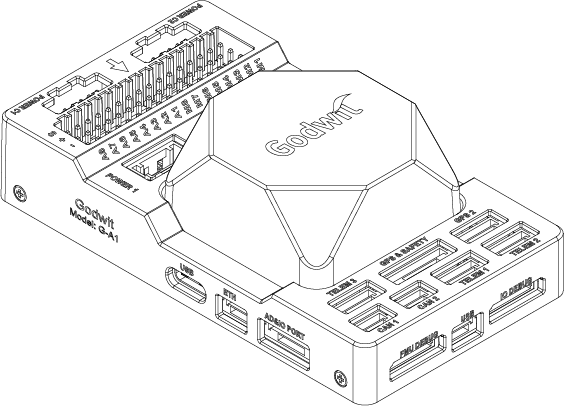
Product Information
硬體一覽
| 項目 | 說明 |
|---|---|
| FMU處理器 | STM32H753 (Arm® Cortex®-M7, 480MHz) |
| IO處理器 | STM32F103 (Arm® Cortex®-M3, 72MHz) |
| 記憶體 | 2M快閃記憶體及1M RAM |
| 感測器 |
|
| IO介面 |
|
| MicroSD卡 | 不包含於配件中。 |
| 電源需求 | 4.6V ~ 5.7V |
| 額定電流 |
|
| 操作溫度 | -40°C ~ +55 °C |
| 儲存溫度 | -40°C ~ +70 °C |
| 操作濕度 | 5% ~ 95% (無冷凝) |
| 外殼材質 | ABS (底板),鋁壓鑄 (IMU上蓋) |
| 尺寸 | 92.2 (長) x 51.2 (寬) x 28.3 (高) mm |
| 重量 | 77.6 g |
針腳定義
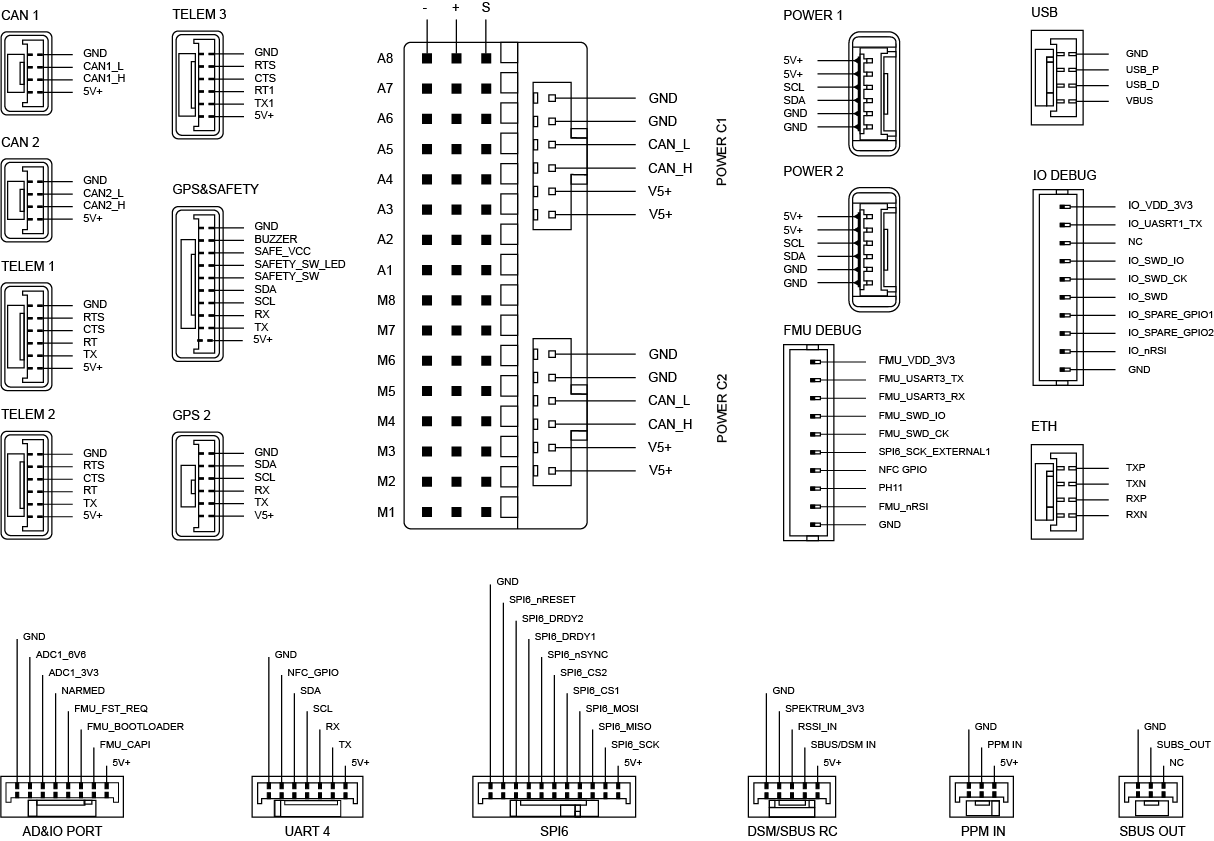
接線
下圖為G-A1及其週邊設備的連接參考圖。
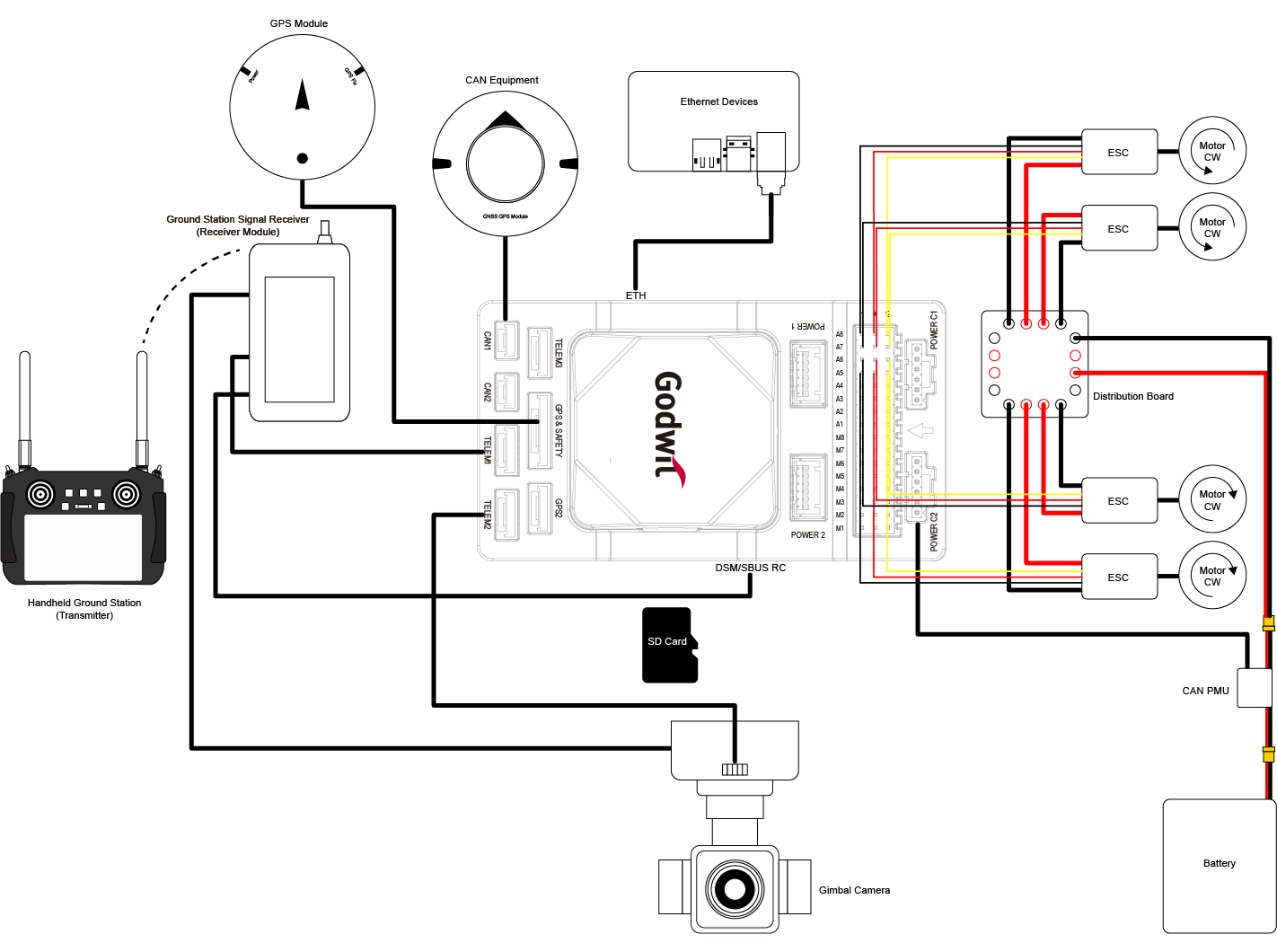
| 介面 | 功能 |
|---|---|
| POWER C1 | 將CAN PMU連接至POWER C1,該埠用於連接UAVCAN電源模組。 |
| POWER C2 | 將CAN PMU連接至POWER C2,該埠用於連接UAVCAN電源模組。 |
| POWER 1 | 連接至SMbus (I2C)電源模組。 |
| POWER 2 | 連接至SMbus (I2C)電源模組。 |
| GPS&SAFETY | 連接至GPS模組 (含GPS、安全開關與蜂鳴器介面)。 |
| GPS2 | 連接GPS/RTK模組。 |
| UART 4 | 用戶自定義用途。 |
| TELEM1/TELEM2/TELEM3 | 連接遙測(telemetry)或MAVLink裝置。 |
| MicroSD | 插入MicroSD卡以儲存日誌。 |
| A1-A8 | 可定義為PWM/GPIO,支援Bdshot,用於相機快門、伺服馬達等。 |
| M1-M8 | 從IO輸出PWM,連接至ESC (electronic speed control)與伺服馬達。 |
| USB | 連接G-A1至電腦進行通訊,如下載韌體。 |
| CAN1/CAN2 | 連接至Dronecan/UAVCAN裝置。 |
| DSM/SBUS/RSSI | 此為DSM/SBUS/RSSI訊號輸入介面,可用於連接DSM衛星接收器、SBUS遙控接收器,或RSSI訊號強度回傳模組。 |
| PPM | 連接至PPM RC接收器。 |
| ETH | 連接至Ethernet裝置。 |
| AD&IO | 連接類比輸入(ADC3.3 or ADC6.6)介面。通常不會使用。 |
| FMU Debug | 供專業人員及開發者使用。 |
| IO Debug | 供專業人員及開發者使用。 |
序列埠對應
| UART | 裝置 | 連接埠 |
|---|---|---|
| USART1 | /dev/ttyS0 | GPS |
| USART2 | /dev/ttyS1 | TELEM3 |
| USART3 | /dev/ttyS2 | Debug Console |
| UART4 | /dev/ttyS3 | UART4 |
| UART5 | /dev/ttyS4 | TELEM2 |
| USART6 | /dev/ttyS5 | PX4IO/RC |
| UART7 | /dev/ttyS6 | TELEM1 |
| UART8 | /dev/ttyS7 | GPS2 |
功耗
電壓
| 參數 | 最小值 | 標準值 | 最大值 |
|---|---|---|---|
| 4.6V | 5V | 5.4V |
電流
| 參數 | 標準值 | 最大值 |
|---|---|---|
| G-A1及組件 | 3.0Amp | 3.44Amp |
| 僅G-A1 | 0.44Amp | 0.58Amp |
快速安裝
本快速指南將說明如何為G-A1供電,並連接其週邊設備。請參考以下說明,正確連接感測器與週邊模組。
其他操作介紹,請參考以下連結之說明:
機體方向
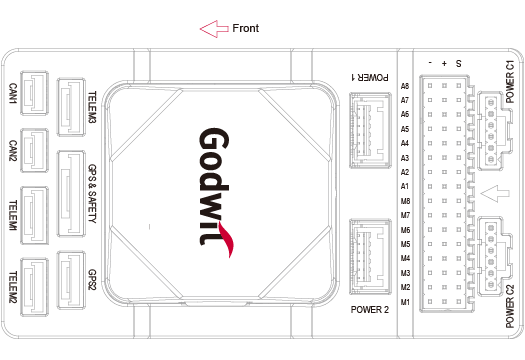
注意:
如果無法將G-A1安裝在建議的預設方向(例如受到空間限制),請在自動駕駛軟體(autopilot software)中設定實際使用的安裝方向。
GPS
建議使用CAN/UAVCAN GPS/RTK,只需將其連接到CAN 1/2介面即可。或者使用一般的GPS/RTK模組,並將其連接至GPS介面。GPS模組通常整合了GPS、指南針、安全開關、蜂鳴器和LED狀態指示燈。安裝模組時,應將其安裝在支架上,遠離其他電子設備,並朝向底板的前方。
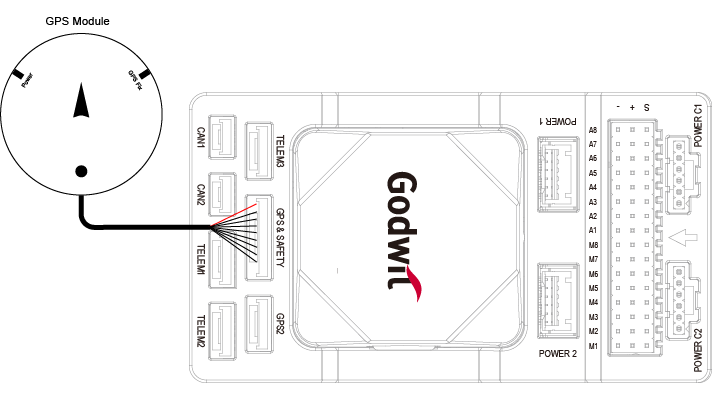
無線電遙控(Radio Control)
連接手持遙控器,即可監控和控制飛行中的無人機。
無線電系統的機上端(airborne end)應連接至TELEM1/TELEM2/TELEM3介面,DSM/SBUS接收器則連接至DSM/SBUS介面,PPM接收器則連接至PPM介面。其他協議的詳細說明,請參看Ardupilot無線電控制系統(Radio Control System)文件。
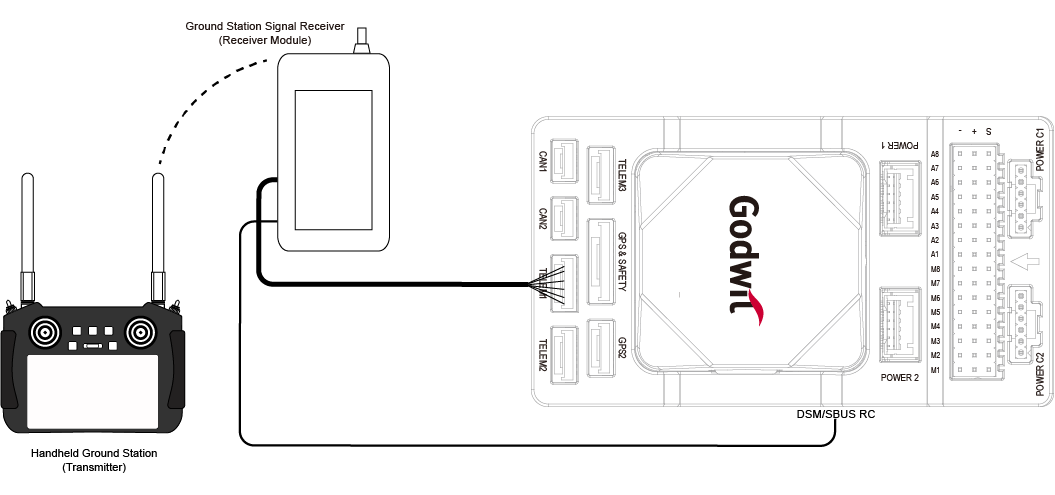
電源
G-A1的CAN PMU模組可支援3-14S鋰電池組。本包裝不包含PMU,請自行準備符合CAN PMU模組規格的PMU。為確保連接正確,請將模組的6針接頭連接到G-A1的Power C1和Power C2介面。
在執行Ardupilot時,控制器即是一個隨插即用的設備,無需多加設定。
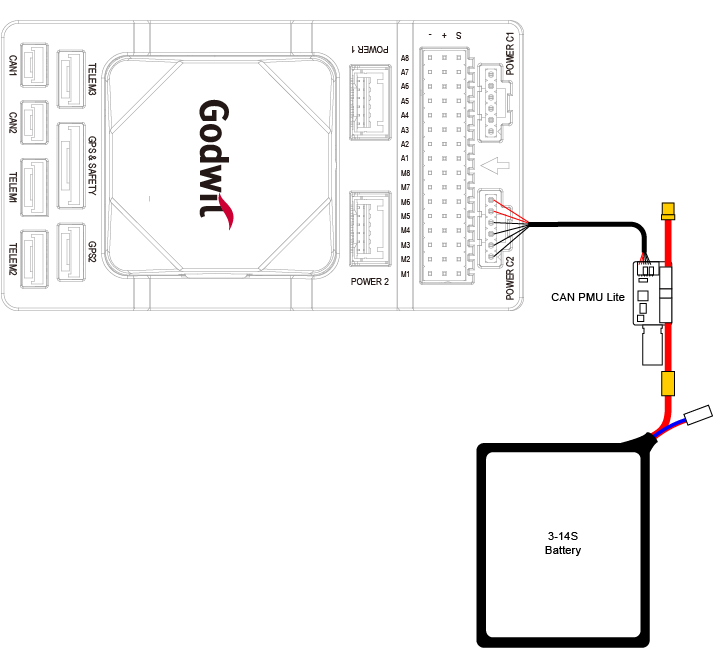
MicroSD卡
包裝中不包含MicroSD卡,請另行準備,並將其插入插槽。
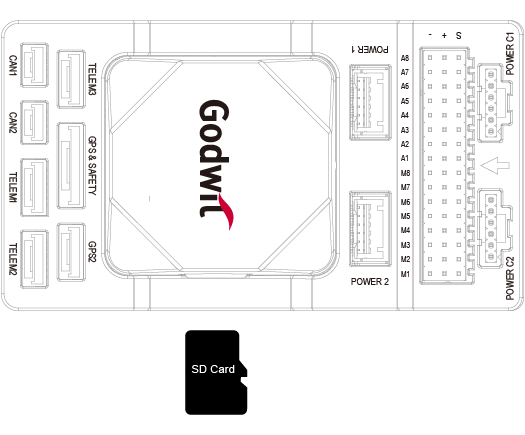
馬達/伺服馬達(Servo)
馬達與伺服馬達應依照所使用的飛行器之機身參考手冊中所列的順序,分別連接至A1–A8或M1–M8腳位。
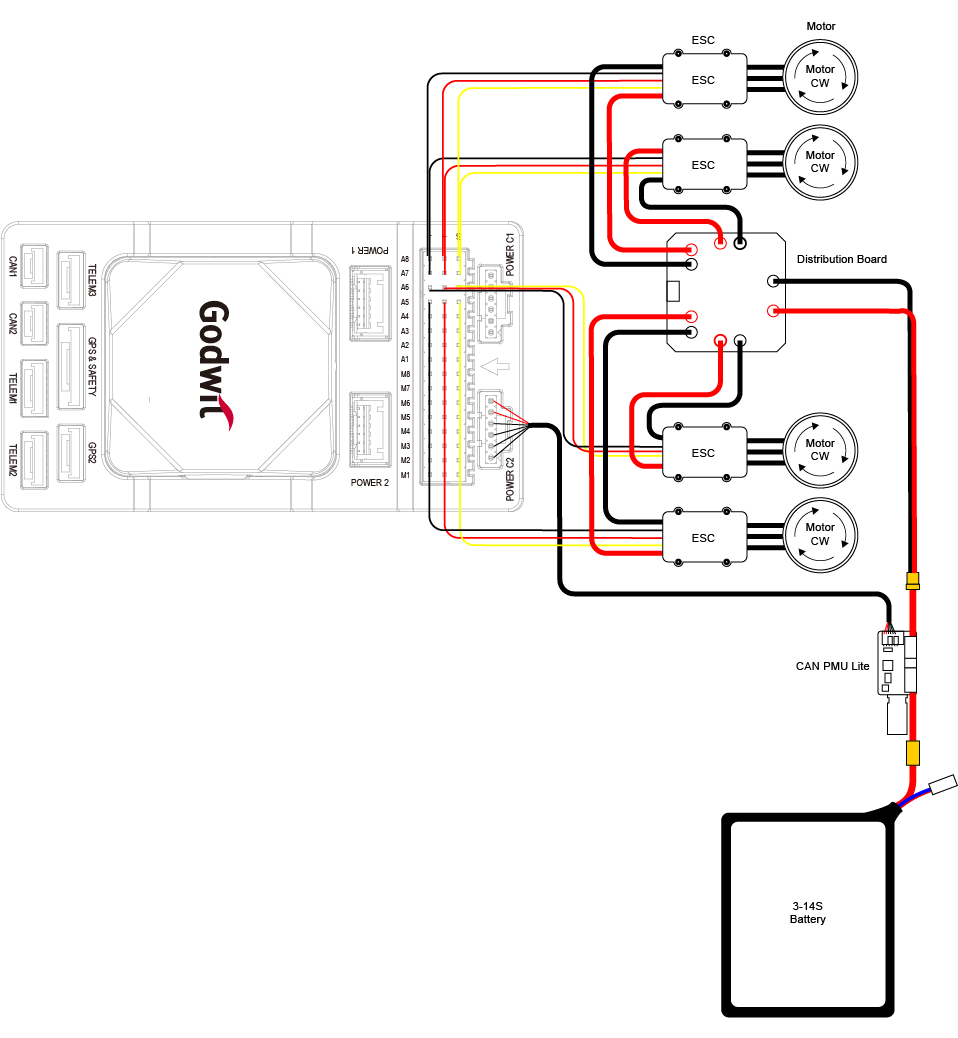
伺服馬達(Servo)供電
G-A1本身不提供伺服馬達電源。若需為伺服馬達供電,必須透過外接的BEC (Battery Eliminator Circuit),並將其正極與負極分別連接至A1–A8或M1–M8連接埠中的任一組腳位。